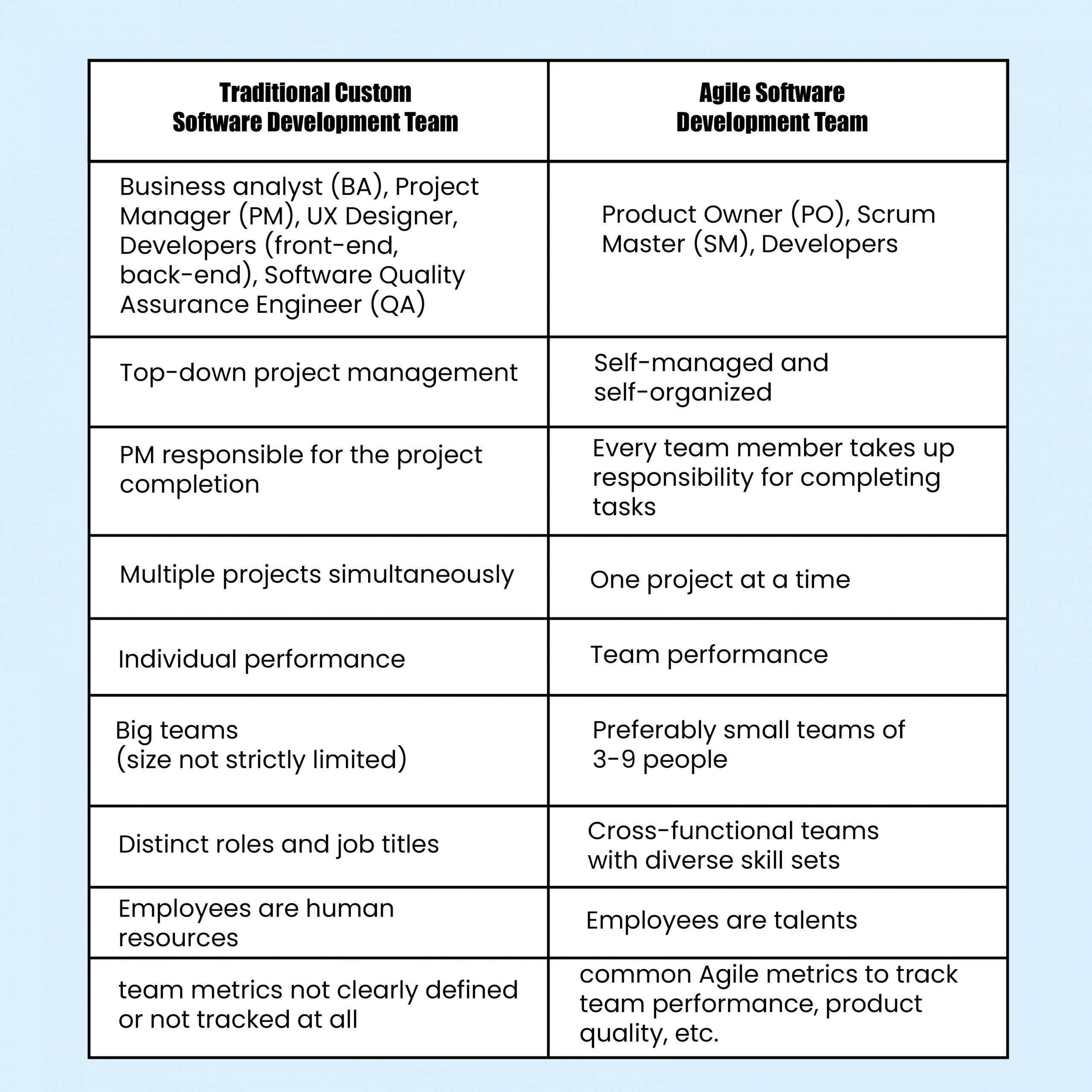Agile Software Development Team Structure: Definition, Roles, & Benefits
The success of an Agile software development team structure is made up of numerous roles and duties working in tandem. An Agile custom software development team, unlike a team that uses traditional development methodologies, focuses on one project at a time. This frequently allows for more team-to-customer collaboration.
Running in parallel, they can complete projects in shorter sprint iterations. So it is vital for you to be aware of the most critical jobs to fill on your Agile development team. This allows for efficient software quality assurance, faster decision-making, and more that will increase the flexibility of your organization.
When you hire software developers in Agile competency, they also help you leverage the most recent emerging technologies, such as artificial intelligence (AI), machine learning (ML), and virtual reality (VR). And this is what makes the Agile framework a highly successful one in every way. Here are some interesting statistics on the success of agile team structure.
So, let’s learn everything you need to know about the Agile software development team structure.
Definition of Agile Software Development Team Structure
An Agile development team structure is a framework for organizing the various aspects of an Agile project team. Project activities, processes, and team responsibilities are elements of these aspects. This framework is essentially a fundamental approach for guiding Agile teams in professional custom software development and organizing their operational processes.
Agile project managers use this adaptable framework since it allows them to steer their teams through a variety of projects. When a team member quits or joins, they can return to the formation stage and begin again. Scaling Agile teams requires this degree of team organization.
When you hire software developers, a good team structure is highly essential as it fosters clarity for everyone to understand their roles. The Agile layer guarantees that the team is adaptable and can respond to changes fast and efficiently. The below agile process frameworks are highly chosen for their efficiency levels.

1. Scrum
Scrum builds a product in a series of fixed-length iterations known as sprints, providing agile teams with a structure for deploying software on a regular cadence. Scrum is most suited for use when a cross-functional team is working on a product development project with a large amount of work that can be divided into more than one 2-4 week iteration.
2. Kanban
Kanban is a well-known methodology for implementing agile and DevOps software development. It necessitates real-time capacity communication and complete transparency of activities. Work items have a visual representation on a Kanban board, allowing team members to monitor the status of all work at any moment.
Traditional Software Development vs Agile Software Development Team Structure
The fundamental difference between traditional and Agile custom software development team structures lies in how individuals collaborate with one another. And it is as follows:

Agile Custom Software Development Team - Roles And Responsibilities
In most cases, an Agile development team structure will specify defined duties for each team member. Even though the emphasis in Agile workflows is on a person's skill set instead of their designation, a defined set of roles can help to generate clarity.
Some of the major team roles when hiring Agile software developers are as follows:
1. Scrum Master (SM)
A Scrum master is a team leader for the Scrum framework. It was developed as part of the Scrum methodology. The name was originally intended to denote someone who is knowledgeable with Scrum and can thus coach others.
In most cases, the job has no practical authority in an Agile software development team structure. People in this position must lead from a position of power, frequently employing a servant-leadership approach.
The Scrum Master is the team member in charge of ensuring that the custom software development team lives agile ideals and principles. Scrum masters also ensure the team adheres to the methods and practices committed to employing for the project.
2. Product Owner (PO)
A product owner represents the client's requirements. It is their responsibility to clearly identify the client’s requirements and ensure that they are satisfied all through the Agile project's entire life cycle. When clients hire software developers, POs will communicate with the team on a frequent basis. They will provide advice on which features to include and update them on what needs to be prioritized.
3. Development Team Members
Development team members is a comprehensive term that can refer to a multitude of roles in many sectors. An Agile development team, for instance, will include programmers, UX designers, software developers, and software quality assurance testers. In comparison, a digital marketing team can comprise copywriters, editors, PPC managers, SEO professionals, and others. Under an Agile team structure, all of these people are considered team members.
4. Stakeholder
Although a stakeholder is not actively participating in project operations, they do play a vital role in defining the final deliverables.
Stakeholders will consult with the Agile development team lead, product owner, and team members on a regular basis to provide feedback on the development process. Their opinion might have a big impact on the project's final outcome. End-users, investors, and senior company executives are examples of stakeholders.
Other responsibilities in a bigger Agile custom software development team structure might include independent testers, enterprise architects, system integrators, and subject matter experts.
Benefits of Employing an Agile Software Development Team

The perks when employing an Agile software development team structure derive from the adoption of an Agile mindset.
It influences how the team tackles the project and accepts responsibility for a job well done. It all comes down to the values and concepts that instill a sense of personal responsibility and make each team member invested in a successful delivery.
The following are some of the benefits associated with having an effective Agile development team:
Effective communication and collaboration: It necessitates teamwork. The hired software developers or team members communicate what they are working on and any bottlenecks. Since delivery is dependent on numerous individuals, regular communication ensures that dependencies are adequately handled and that any concerns are resolved as soon as possible.
Shared goal: The characteristics of an Agile custom software development team are that all members are focused and work together to achieve the same goal. This goes beyond ensuring that your own part of the project is accomplished. An Agile team handles dependencies and ensures that there is strong teamwork and that multi-person jobs are done so they don't become static.
Responsibilities are well defined: All of the Agile development team members are aware of their responsibilities and the extent of their tasks. From the get-go, roles, and expectations are clearly defined.
Powerful team culture: This is the essence of Agile. Its values and principles form the groundwork for a healthy and goal-oriented organizational culture. Embracing the Agile software development team structure and being a member of this mindset fosters a culture of mutual respect and support. That is the formula for effective collaboration.
There is no need to be pushy and bossy: The staff is concerned with performing the work well and producing outstanding outcomes. This saves time and allows you to concentrate on your company goals.
Flexibility and responsiveness to change: The cornerstone of Agile custom software development is being adaptable and making changes to the project as new customer requirements emerge. Since this is the standard in an Agile development process, the team responds quickly to customer feedback and requires less time to change. Its flexibility improves product quality and delivery time, saves money, and is a significant financial benefit.
Quicker time to market: When faced with an urgent requirement to build a product for new markets, engaging an Agile development team helps you to drastically improve product delivery time. The Agile framework allows you to keep up with rising market demand and provide ready-to-use products in a couple of weeks.
Enhanced Product Quality: Since an Agile team is prepared to implement change and conducts quality software quality assurance/testing throughout the development process, the finished result is high-quality and meets requirements and industry standards. The team does this by establishing an effective feedback loop and keeping constant communication with the customer. At each iteration, the client is presented with a completed increment and provides input, which is then used to modify the work.
Cost-saving: Everyone in an Agile software development team structure understands what needs to be done. Any key modifications to the project may be made early in the development process, in addition to iterative development and frequent delivery. This significantly reduces costs
- as compared to situations of misunderstanding
- or when requirements are not correctly specified from the start
- and cannot be reviewed prior to the completion of development.
The Grand Wrap-Up
Having a strong Agile software development team structure in a business is what makes Agile methodology implementation successful. A competent Agile development team delivers products quickly and continuously, and it is flexible and adaptive enough to integrate new requirements at any stage of project development.
Therefore make sure you hire the proper developers for the job from an industry-accomplished custom software development company.


